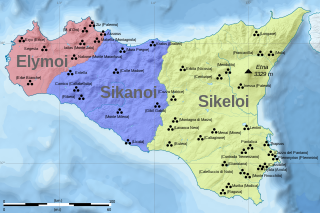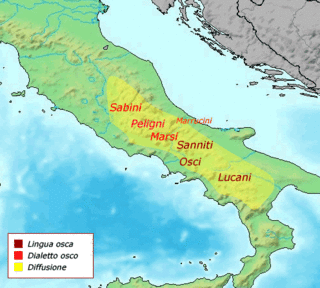
Veii was an important ancient Etruscan city situated on the southern limits of Etruria and 16 km (9.9 mi) north-northwest of Rome, Italy. It now lies in Isola Farnese, in the comune of Rome. Many other sites associated with and in the city-state of Veii are in Formello, immediately to the north. Formello is named after the drainage channels that were first created by the Veians.

Fidenae was an ancient town of Latium, situated about 8 km north of Rome on the Via Salaria. Its inhabitants were known as Fidenates. As the Tiber was the border between Etruria and Latium, the left-bank settlement of Fidenae represented an extension of Etruscan presence into Latium. The site of the arx of the ancient town was probably on the hill on which lies the contemporary Villa Spada, though no traces of early buildings or defences are to be seen; pre-Roman tombs are in the cliffs to the north. The later village lay at the foot of the hill on the eastern edge of the high-road, and its curia, with a dedicatory inscription to Marcus Aurelius by the Senatus Fidenatium, was excavated in 1889. Remains of other buildings may also be seen.

The Osci were an Italic people of Campania and Latium adiectum before and during Roman times. They spoke the Oscan language, also spoken by the Samnites of Southern Italy. Although the language of the Samnites was called Oscan, the Samnites were never referred to as Osci, nor were the Osci called Samnites.

Falerii is a village in the municipality of Fabrica di Roma in the Province of Viterbo, Italy. Its name is better known for two nearby ancient cities, Falerii Veteres and Falerii Novi.

The Falisci were an Italic tribe who lived in what is now northern Lazio, on the Etruscan side of the Tiber River. They spoke an Italic language, Faliscan, closely related to Latin. Originally a sovereign state, politically and socially they supported the Etruscans, joining the Etruscan League. This conviction and affiliation led to their ultimate near destruction and total subjugation by Rome.

The Volsci were an Italic tribe, well known in the history of the first century of the Roman Republic. At the time they inhabited the partly hilly, partly marshy district of the south of Latium, bounded by the Aurunci and Samnites on the south, the Hernici on the east, and stretching roughly from Norba and Cora in the north to Antium in the south. Rivals of Rome for several hundred years, their territories were taken over by and assimilated into the growing republic by 304 BC. Rome's first emperor Augustus was of Volscian descent.
The Hernici were an Italic tribe of ancient Italy, whose territory was in Latium between the Fucine Lake and the Sacco River (Trerus), bounded by the Volsci on the south, and by the Aequi and the Marsi on the north.

Volscian was a Sabellic Italic language, which was spoken by the Volsci and closely related to Oscan and Umbrian.

The Sicani or Sicanians were one of three ancient peoples of Sicily present at the time of Phoenician and Greek colonization. The Sicani dwelt east of the Elymians and west of the Sicels, having, according to Diodorus Siculus, the boundary with the last in the ancient Himera river (Salso) after a series of battles between these tribes.

The concept of Italic peoples is widely used in linguistics and historiography of ancient Italy. In a strict sense, commonly used in linguistics, it refers to the Osco-Umbrians and Latino-Faliscans, speakers of the Italic languages, a subgroup of the Indo-European language family. In a broader sense, commonly used in historiography, all the ancient peoples of Italy are referred to as Italic peoples, including those who did not speak Indo-European languages such the Rhaetians, Ligures and Etruscans. As the Latins achieved a dominant position among these tribes, by virtue of the expansion of the Roman civilization, the other Italic tribes adopted Latin language and culture as part of the process of Romanization.
Sabellians is a collective ethnonym for a group of Italic peoples or tribes inhabiting central and southern Italy at the time of the rise of Rome. The name was first applied by Niebuhr and encompassed the Sabines, Marsi, Marrucini and Vestini. Pliny in one passage says the Samnites were also called Sabelli, and this is confirmed by Strabo. The term Sabellus is found also in Livy and other Latin writers, as an adjective form for Samnite, though never for the name of the nation; but it is frequently also used, especially by the poets, simply as an equivalent for the adjective Sabine.
The Albans were Latins from the ancient city of Alba Longa, southeast of Rome. Some of Rome's prominent patrician families such as the Julii, Servilii, Quinctii, Geganii, Curiatii and Cloelii were of Alban descent.

Latium is the region of central western Italy in which the city of Rome was founded and grew to be the capital city of the Roman Empire.
The Roman–Etruscan Wars, also known as the Etruscan Wars or the Etruscan–Roman Wars, were a series of wars fought between ancient Rome and the Etruscans. Information about many of the wars is limited, particularly those in the early parts of Rome's history, and in large part is known from ancient texts alone. The conquest of Etruria was completed in 265–264 BC.

The Aborigines in Roman mythology are the oldest inhabitants of central Italy, connected in legendary history with Aeneas, Latinus and Evander. They were supposed to have descended from their mountain home near Reate upon Latium, where they expelled the Sicels and subsequently settled down as Latini under a King Latinus.

The Latins, sometimes known as the Latials or Latians, were an Italic tribe that included the early inhabitants of the city of Rome. From about 1000 BC, the Latins inhabited the small region known to the Romans as Old Latium, the area in the Italian Peninsula between the river Tiber and the promontory of Mount Circeo 100 km (62 mi) southeast of Rome. Following the Roman expansion, the Latins spread into the Latium adiectum, inhabited by Osco-Umbrian peoples.
Old Latium is a region of the Apennine Peninsula bounded to the north by the Tiber River, to the east by the central Apennine Mountains, to the west by the Mediterranean Sea and to the south by Monte Circeo. It was the territory of the Latins, an Italic tribe which included the early inhabitants of the city of Rome. Later it was also settled by various Italic tribes such as the Rutulians, Volscians, Aequi, and Hernici. The region was referred to as "old" to distinguish it from the expanded region, Latium, that included the region to the south of Old Latium, between Monte Circeo and the river Garigliano – the so-called Latium adiectum. It corresponded to the central part of the modern administrative region of Lazio, Italy, and it covered an area measuring of roughly 50 Roman miles. It was calculated by Mommsen that the region's area was about 1860 square kilometres.

The Campanians were an ancient Italic tribe, part of the Osci nation, speaking an Oscan language.
Lucius Furius Medullinus, of the patrician gens Furia, was a politician and general of the Roman Republic who was consul twice and Consular Tribune seven times.
















